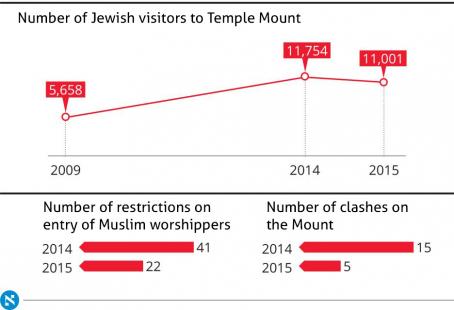Prime Minister Benjamin Netanyahu promised the Jordanians in November 2014 that he would stop Israeli politicians from visiting Jerusalem’s Temple Mount and limit visits by right-wing activists, according to a new report by an international organization devoted to resolving conflicts around the world. A local nongovernmental organization, meanwhile, reported declines in the number of Jews visiting the Temple Mount and in violent clashes at the site.
The report issued by International Crisis Group discloses details of the agreements between Netanyahu and Jordan’s King Abdullah II on the Temple Mount and describes their context. It is based on interviews with decision-makers in Israel, Jordan and the Palestinian Authority.
In November 2014 Netanyahu went to Amman for talks on ending violent clashes on the Temple Mount between Palestinians and Israeli security forces, set off by the gruesome murder of Mohammed Abu-Khdeir, a 16-year-old Palestinian boy, by Jewish extremists.
The two leaders agreed on four points, according to the report. Netanyahu pledged to keep Israeli lawmakers from visiting the Temple Mount and to limit, as much as possible, visits by Jewish extremists. He also undertook to stop placing age and gender restrictions on Muslim visitors to the site. In return, the king promised that the Waqf, the Muslim trust that oversees the site, would block young Palestinian men from spending the night at the compound in order to prepare for violent confrontations with the police, as had occurred on several occasions.
Shortly after Netanyahu’s trip to Jordan, visits by Israeli politicians stopped and so-called Temple Mount activists reported that the Israel Police impeded their access to the compound. The police also lifted restrictions on Muslim entry, and relative calm returned for several months, although violent clashes continued in East Jerusalem between Palestinians and police.
But the new arrangements collapsed last fall, after then-Interior Minister Gilad Erdan ordered a group of Muslim women activists barred from the Temple Mount and Agriculture Minister Uri Ariel visited it.
The Jordanians considered these two moves a breach of the agreement, and confrontations resumed. Calm was once again restored after U.S. Secretary of State John Kerry visited Jordan in October 2015. This time the king refused to meet with Netanyahu. According to the new agreement, Netanyahu pledged that the status quo, by which “Muslims will pray on the Mount, non-Muslims will visit” would be preserved.
The new agreement also called for closed-circuit cameras to be installed on the Temple Mount. The cameras were not installed, but in the past several weeks there has reportedly been progress in talks on the issue. Over the past few weeks leaflets in Arabic have been distributed at the site calling on Muslims to break the cameras.

Meanwhile, data obtained from the Police as part of a Freedom of Information request by the Ir Amim NGO, show that in 2015 the number of visits to the Temple Mount by Jews fell for the first time in five years. It is not clear whether this happened due to Israeli commitments or for other reasons. In 2015, a total of 11,001 Jews visited the site, compared to 11,754 in 2014. In the five years preceding 2014, there was a constant increase in the number of Jewish visitors to the Mount. In 2009, in comparison, only 5,268 Jewish visitors went there.
The data presented to Ir Amim indicate further that despite the wave of violence in Jerusalem since October 2015, throughout the year 2015 there were only five clashes between the Police and Palestinian rioters on the Temple Mount, versus 15 such incidents in 2014. Last year the Police imposed collective restrictions 22 times on the entry of Muslims to the Mount (largely age-based restrictions), 17 of which were on Jewish holidays. In 2014 the Police imposed restrictions in 41 cases.
An analysis by Ir Amim researcher Aviv Tatarsky reveals the relationship between collective restrictions and the deterioration of the security situation in Jerusalem. “First of all there is a statistical correlation; every time there are restrictions we have seen the violence spread,” Tatarsky says. “Secondly, I have seen it with my own eyes more than once. The Police close the Temple Mount and sets up a lot of checkpoints in the Old City alleyways, and that disrupts life there. People start to demonstrate in front of the checkpoints, and there will always be someone who shouts too loudly and pushes a police officer, who fires a stun grenade, and within two hours it spins out of control. Palestinian television broadcasts that Israel is taking over Al-Aqsa and the violence spreads.” […]
The Prime Minister's Office said that Netanyahu did not limit Jewish access to the Temple Mount at any stage, and certainly did not specifically limit visits by religious Jews. The statement also noted that the only restrictions apply to MKs and ministers, both Arab and Jewish, which currently remain in effect. The statement said further that the Israeli government upholds and is committed to the status quo. In advance of the Passover holiday, all parties are called upon to show responsibility and restraint in order to maintain quiet on the Temple Mount, it was stated.


